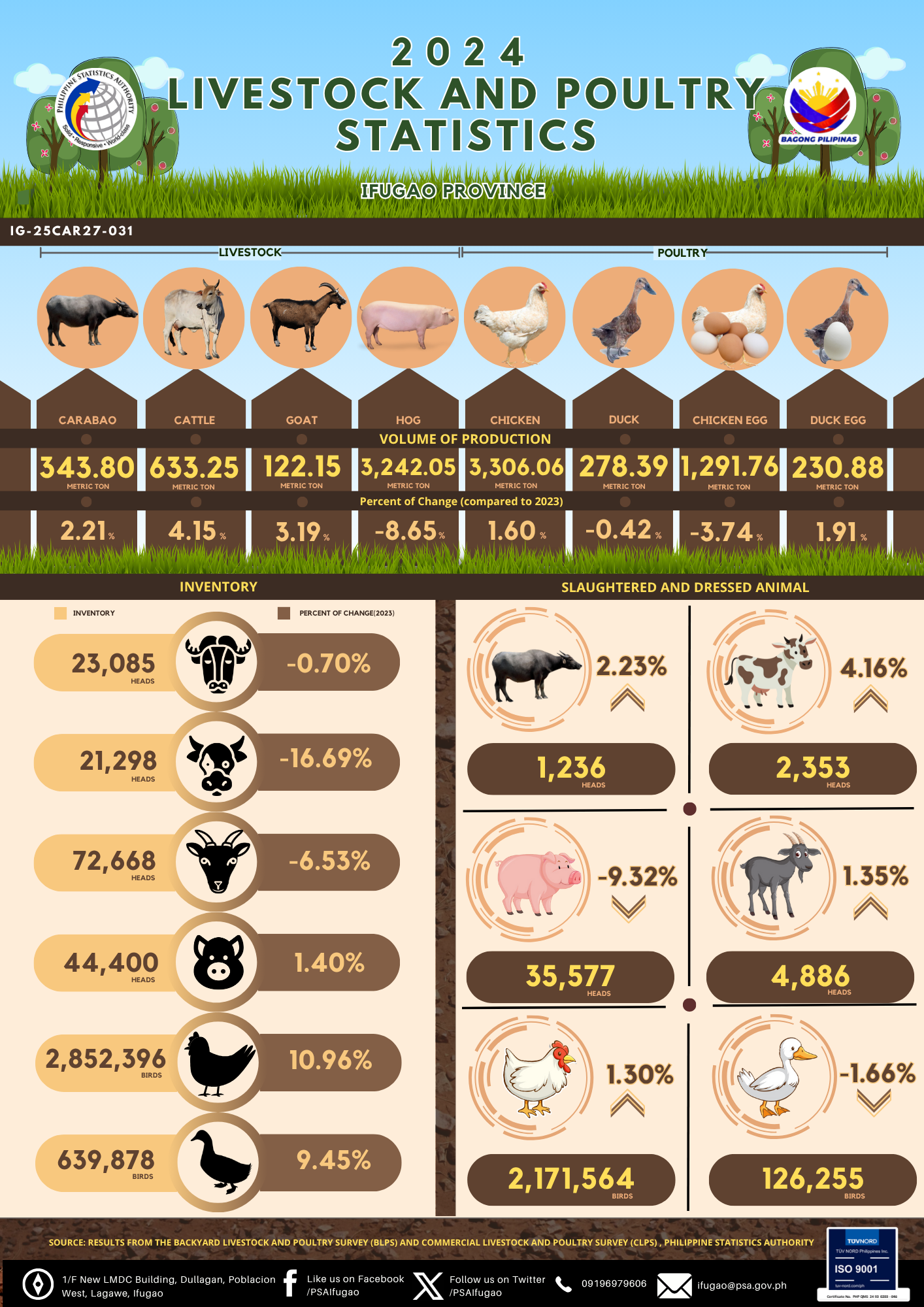The Philippine Statistics Authority (PSA) regularly conducts core agricultural surveys to monitor production dynamics nationwide. Among these, the Backyard and Commercial Livestock and Poultry Surveys serve as critical data sources, gathering inventory, supply, and disposition estimates from households and commercial farms across the country.
This special release presents the regional performance of the livestock and poultry sector in the Cordillera Administrative Region (CAR) for the year 2024, highlighting production volumes of major commodities: carabao, cattle, hog, and goat for livestock, and chicken, chicken eggs, duck, and duck eggs for poultry.
Livestock yield falls in 2024
In 2024, the Cordillera Administrative Region (CAR) recorded an estimated total livestock production of 27,690 metric tons. This comprised 21,263 metric tons of hog, 3,232 metric tons of cattle, 2,291 metric tons of carabao, and 904 metric tons of goat.
Compared to the previous year, the total volume declined by 3.1% from 28,583 metric tons in 2023.
Hog production posted a 3.9% drop in 2024, marking it as the most significantly contracting sub-sector of the region's livestock industry. Carabao production also declined by 2.3%. In contrast, cattle production increased marginally by 0.2%, while goat production experienced a 1.8% increase.
As for the composition of CAR’s livestock production, hogs dominated with approximately 76.8% share. Cattle made up 11.7%, while carabao and goat contributed 8.3% and 3.3%, respectively.
Figure 1. Livestock Production and Percent Share
by Animal Type, CAR: 2024
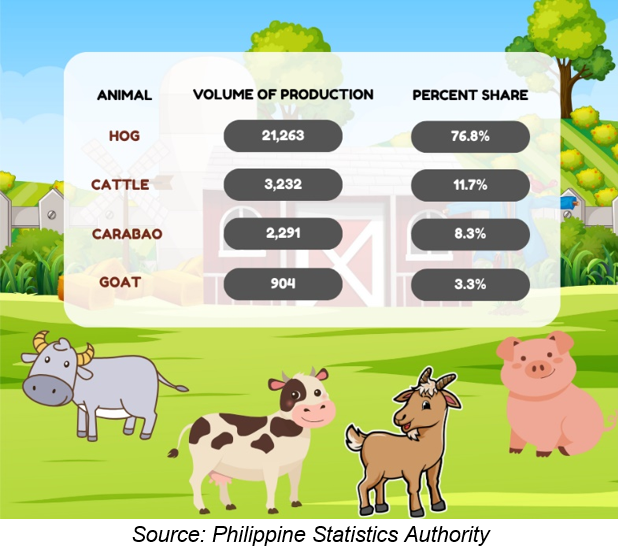
The Philippines produced 2,133,778 metric tons of livestock in 2024. CAR remained among the smallest regional contributors, accounting for only 1.3% of the country's total livestock output.
Figure 1 presents the trend in livestock production in CAR from 2022 to 2024. Following a production of 27,049 metric tons in 2022, the region exhibited an inconsistent trajectory, with production inclining to 28,583 metric tons by 2023, then declining to 27,690 metric tons by 2024.
Figure 2. Livestock Production, CAR:
2022, 2023 and 2024
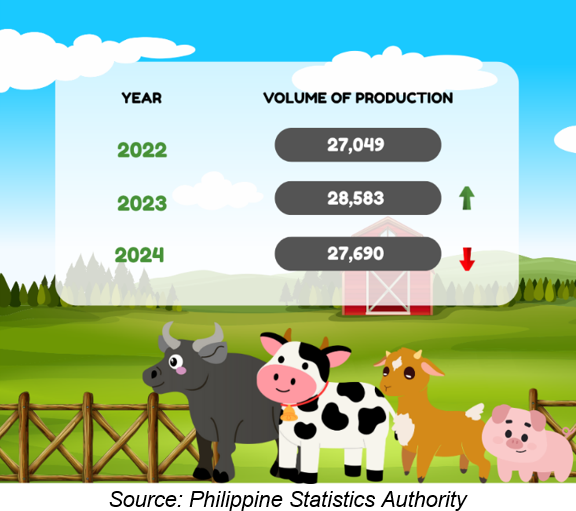
Poultry production declines in 2024
In 2024, the Cordillera Administrative Region (CAR) recorded a total livestock production of 12,317 metric tons, reflecting a 5.6% decrease from the 13,011 metric tons registered in 2023. This decline disrupted the upward trajectory observed in the preceding year.
The composition of this production was predominantly comprised of chicken, which yielded and accounted for 6,618 metric tons or approximately 53.7% of the region’s total poultry production. Duck contributed 623 metric tons (5.1%), duck eggs contributed 636 metric tons (5.2%) and chicken eggs contributed 4,440 metric tons (36%).
Figure 3. Poultry Production and Percent Share by Animal Type,
CAR: 2024
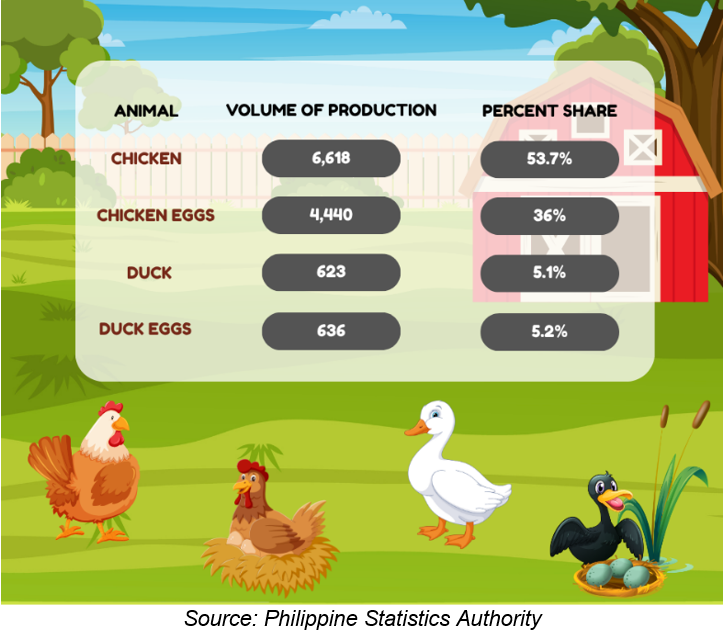
Among the principal poultry categories, chicken eggs production experienced the most pronounced decline at 13.6%, demonstrating its persistent exposure to risks in the local agri-livestock and poultry industry. Duck production also exhibited a negative trajectory, contracting by 1.8%, as well as duck eggs by 0.3%. Conversely, marginal growth was recorded in chicken production, which increased by 0.3%.
Figure 4. Poultry Production, CAR:
2022, 2023 and 2024
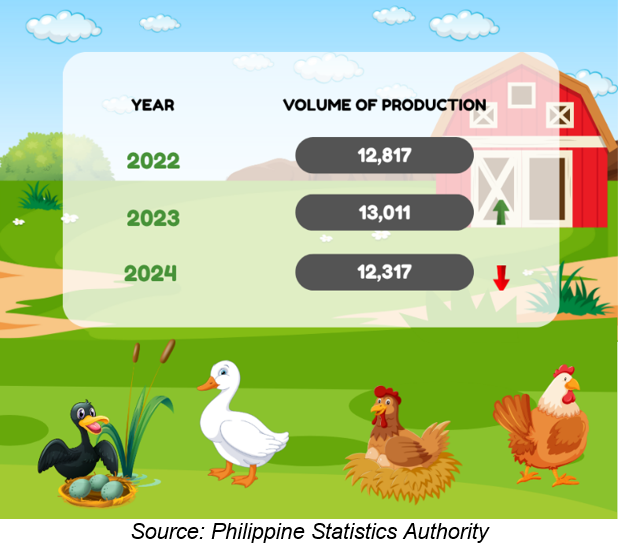
Despite the regional significance of these figures, CAR’s contribution to the national livestock output remained modest. The region accounted for a mere 0.4% of the Philippines’ total livestock production of 2,942,871 metric tons in 2024.
Figure 4 illustrates the trend in poultry production across the Cordillera Administrative Region (CAR) from 2022 to 2024. Starting at 12,817metric tons in 2022, production rose to 13,011 metric tons in 2023 before dipping slightly to 12,317 metric tons in 2024, reflecting a fluctuating pattern over the three-year period.
(SGD)
ALDRIN FEDERICO R. BAHIT, JR.
(Chief Statistical Specialist)
Officer-In-Charge
Special Order No: 2025ORDCAR-212
Designation Initials Date
CSS AFRB 28 July 2025
SA DBRGL 26 June 2025
Technical Notes
The data for this publication were collected by PSA through the two surveys, namely, Backyard Livestock and Poultry Survey (BLPS) and the Commercial Livestock and Poultry Survey (CLPS).
Livestock refers to farm animals kept or raised for consumption, work, or leisure. In general, poultry is separated as a distinct group of farm animals. For purposes of censuses and surveys, livestock covers only those that are tended and raised by an operator.
Livestock/Poultry Production refers to the volume of indigenous (locally-raised) animals disposed for slaughter plus animals exported or shipped-out for slaughter both in liveweight equivalent.
Poultry is a collective term for all domesticated avian for the purpose of food consumption or, the carcass of such avian dressed/processed for human consumption. Fowl is a term used to refer to a specific group of avian sharing common anatomical characteristics, e.g., chicken and turkey.



